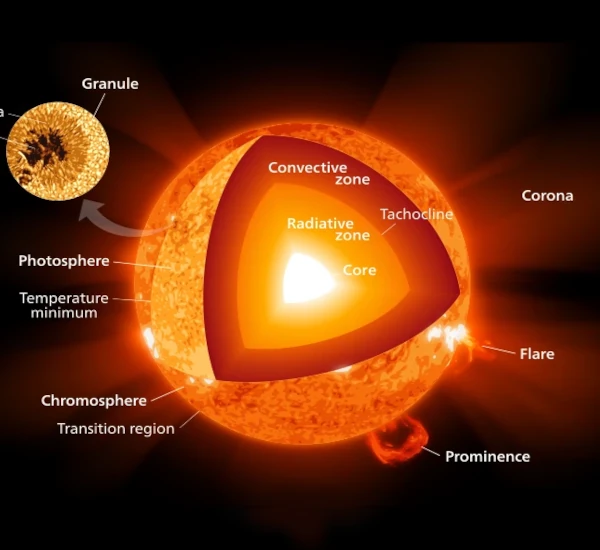
About 4.57 billion years ago, a gravitational instability in a giant molecular cloud—mainly composed of hydrogen and interstellar dust—initiated the collapse of matter. The progressive compression caused the temperature and pressure at the center of this protostar to rise. When the temperature exceeded 10 million kelvins, the thermonuclear fusion of hydrogen nuclei into helium began via the proton-proton chain. This exothermic process released enough energy to counteract gravity: the Sun was born.
The Sun converts about 564 million tons of hydrogen into 560 million tons of helium every second. The difference of 4 million tons is transformed into energy according to the relativistic equation \( E = \Delta m \cdot c^2 \), or about \(3.8 \times 10^{26}\) watts. This represents 3,800 billion times the combined power of the 439 nuclear reactors worldwide recorded in 2011. This energy flow is responsible for the thermal structuring of the entire Solar System, maintaining the planets in distinct habitability zones.
At 150 million kilometers, Earth receives only a tiny 2 billionths of this energy, but this is enough to maintain an average global temperature of 15°C, essential for life.
Since its birth 4.57 billion years ago, the power radiated by the Sun has not remained constant. Stellar evolution models indicate that a yellow dwarf star, like the Sun, sees its luminosity slowly but continuously increase due to the gradual transformation of hydrogen into helium in the core, which increases the central temperature and the rate of fusion reactions.
Solar luminosity increases on average by about 10% per billion years. Thus, at its formation, the Sun radiated only about 70% of its current power, or:
This gradual increase has a direct impact on Earth's climate. On a geological scale, it is suspected of having altered Earth's radiative balance since the Archean, influencing the evolution of the atmosphere and biosphere. In the long term, this gradual warming will make the Earth's surface uninhabitable long before the end of the Sun's life.
The Sun is a sphere of plasma whose mass composition is dominated by hydrogen (74%) and helium (24%), with the remainder consisting of metals in the astrophysical sense: oxygen, carbon, iron, neon, etc. In the core, the temperature reaches 15 million kelvins and the density about 150 g/cm³. The thermal agitation is such that electrons are torn from atomic nuclei, forming a perfectly ionized plasma. Some of the coronal matter continuously escapes in the form of charged particles—electrons and protons—constituting the solar wind, which propagates at speeds of 300 to 800 km/s.
By interacting with the Earth's magnetosphere, the solar wind induces currents of energetic particles that penetrate the polar atmospheric layers. These interactions excite nitrogen and oxygen molecules, producing the northern and southern lights, mainly in green (557.7 nm), red (630.0 nm), and blue wavelengths. Comets, on the other hand, reveal the direction of the solar wind through the formation of an ionic tail, always oriented opposite the Sun.
Currently in the main sequence phase, the Sun produces its energy by fusing hydrogen into helium in its core. This stable phase will last another approximately 5 billion years. Then, the core will collapse on itself, causing the outer layers to expand: the Sun will become a red giant, probably engulfing Mercury, Venus, and possibly Earth. It will end its life as a white dwarf, leaving behind a planetary nebula. Until then, it will continue to supply energy to the Earth's biosphere.